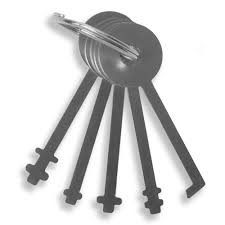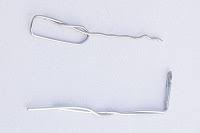The post How To Pick Locks appeared first on .
]]>

They came in handy helping buddies in the Army and in college who lost keys, or locked themselves out. And I rented places that had the cheaper locks that many places have, and I was able to get myself back in when locked out.
Tools You’ll Need
To open standard locks, you’ll need two tools (Something a lot of TV shows and movies get wrong): a tension wrench and an L rake. A tension wrench is a tool with a 90-degree angle that’s used to apply pressure to the lock. In the top picture above, the tension wrench is horizontal above the different rakes in the set. An L rake is designed to push the cylinder pins into the correct position to open the lock.
The second picture above is a set of warded lock picks. These will open may types of locks found on file cabinets, small lock boxes, and certain kinds of pad locks. I liked it when buddies had those kinds of padlocks as I could open them really quick and it made me look good.
Improvised Lock Picks
While I always teach that it’s better to have the right tool for the job than improvise, sometimes we have no choice. Many common items can be used to pick some locks. Things like bobby pins, hairpins, bits of wire, and paperclips can be turned into tension wrenches and picks. Two paper clips can be used to pick some of the cheaper standard locks. Straighten them out, and then bend one in a 90-degree angle to be your tension wrench. You can create waves or other configurations in the second one to be your rake.

How to Pick a Lock
Lock picking is a handy skill to have, and with a little practice, you will be able to open basic locks. While applying the circular tension with the tension wrench, you rake or lift the pins until they are in line with the shear line and the cylinder turns due to the pressure with the tension wrench. What the youtube video below for more instruction.


Is It Legal?
There is nothing illegal about owning a set of lock picks or knowing how to pick a lock. It’s what you do with the knowledge and tools that makes it legal or not. You should only pick locks on your own property or that you have permission to pick. There was nothing illegal about helping my buddies who lost their keys or locked themselves out. There was nothing illegal about getting into my own place or teaching my daughter how to pick locks. The only time I’ve ever used lock picks illegally was that incident that is not in my novel, and we don’t need to discuss that any further. Only use your tools and knowledge legally and you won’t have anything to worry about.
Video Guide to Picking Locks
Here is a video from The Art of Manliness on picking locks to help with your education.
The post How To Pick Locks appeared first on .
]]>The post How To Cool Down in Summer Heat appeared first on .
]]>Here are a few tips on how to cool down, or what Dave Black calls “Emergency Cooling” from his book What To Do When The Shit Hits The Fan.
How To Cool Down from Dave Black’s Book:
- Prepare for the heat. In the evening open the windows and turn on the fans for cross-ventilation. That will cool the house down. When the sun comes up in the morning, shut all the windows and doors, close the curtains, and leave them shut and closed all day until cooler evening. Then open things up again.
- Drink plenty of water, even if you’re not thirsty, and even if it’s humid. Dehydration will speed the effects of heat illnesses. Alcohol will dehydrate you, and caffeinated, carbonated, and heavily sugared drinks like lemonade are not efficient hydrators. If it’s real hot, drink the coolest water you can find. Be aware that it IS possible to overhydrate. On a hot day with moderate physical activity an adult will go through about a gallon. Too much more than that can cause a condition called hyponatremia, with symptoms similar to those of heat injuries.
- Sports drinks can be beneficial in replacing electrolytes that you have sweated off. Avoid salt tablets unless a doctor tells you otherwise.
- Avoid strenuous activity, and work during the coolest parts of the day (early morning).
- Stay inside, or at least avoid direct sunlight and stay in shaded areas. Outside, wear lightweight, loose-fitting, long-sleeved clothing. A hat with a large brim helps protect against the sun.
- If possible, keep the air moving. Put a fan in an upstairs window to blow off the heat in the upper levels. A fan in a lower window will help create a heat-reducing cross-draft.
- Turn off any sources of heat, including lights and computers. Keep the stove off. Eat foods that don’t require cooking.
- Eat frequent small meals and avoid high protein foods.
- Move to the lowest level of the building (probably the basement). Cold air is more dense and sinks to lower levels. Also, lower levels might stay cooler because of the colder ground it conducts from.
- Wet your wrists with cold or ice water.
- If you’re sweating, use it to your advantage. Stand in a breeze or in front of a fan. When water evaporates, it absorbs heat, drawing it away from the body.
- Get in a tub of water or take a shower if it doesn’t deplete precious water supplies. Sit with your hands or feet in a basin of cold water.
- Fill a glass with ice and blow into it and let your face catch the cool air that comes out.
- Take off your shoes and hats. The head and feet have a big role in regulating body temperature.
- If you can’t keep up with the heat, go to a community shelter where it’s likely to be cooled.
A few more tips that Dave Black provides to turn yourself into a human swamp cooler. If you live in a dry climate, one of these techniques can cool you off considerably:
- Use a squirt bottle to saturate the sleeves of your shirt or the legs of your pants. Evaporation will cool the arms and legs.
- Put on a dripping wet T-shirt. Be prepared for strange looks, but at least you’ll be cooled off for an hour or so.
- Put a wet towel on the back of the next or top of the head.
- Consider wearing a “gutra,” the large white scarf made of a thin breathable material and worn by Arabian men. Make your own out of whatever thin material you can find. Soak it with water and plant yourself in a breeze. Reap the benefits. The author actually tested the cooling efficiency of wet gutras while doing remote backcountry projects in Arabia. The temperature difference between unshaded air outside the gutra and air around the face beneath the gutra is significant.
- Run a fan over an ice chest. It will melt precious ice, but it can provide localized relief for a couple of hours.
- Consider purchasing an expensive portable single-room air conditioner, with the understanding that running it will require about 700 watts or more to cool about 300 square feet. That means you’ll need a generator to run it if the power’s off.
I will be adding more tips to the membership pages on this topic (member benefits), but for now, I hope these tips from Black’s book help you stay cool during the hot days of summer. If you want more advice on What To Do When The Shit Hits The Fan, check out Dave Black’s book on amazon:
The post How To Cool Down in Summer Heat appeared first on .
]]>The post Cold Weather Snow Caves and Staying Warm Outside appeared first on .
]]> Be Smart About Cold Weather
Be Smart About Cold Weather
Cold weather can be dangerous. But not if you are smart about it. I grew up in North Dakota and Montana, so I’m no stranger to the cold. And fortunately, my father did too, so he taught me lessons he learned from growing up in Montana, hunting, fishing, and then time in the military regarding cold weather survival. Cold weather isn’t something to fear if you are prepared and smart about it.
My wife was sometimes curious because I always insisted on having blankets or sleeping bags in the vehicle, extra water, protein bars and snacks, extra warm clothes, a small shovel, and a bag that contained various gear including knives, matches, lighters, cans of Sterno, small saw, mirror, and other items that could be useful in an emergency. Sadly, the story of the Kim family in Oregon in 2006 really made her realize why I insisted on having such items in our vehicle if we left town.
I walk to school every morning, including days where it was below zero and the windchill factor was in the negative double digits. We’ve been fine. There is no way I ever want anything bad to happen to my daughter, so I make sure she is wearing appropriate clothing for the weather, and I monitor her to ensure she is okay when we are out in the cold. I also pay attention to my own body when I am out in the heat or cold, and I know how I am doing. I’ve never had a cold weather or heat injury during my years in the Army or times in extreme climates. So here are a couple of the most important things you should know.
Shelter Is Vital
In a winter survival situation, you must find or build shelter to protect you from the cold, wind and wet. These are the things that will steal your body heat, leading to hypothermia which can kill you. (If your core temperature drops to 92 degrees F (33 degrees C) or less, you won’t be able to help yourself any more.) A snow cave is one kind of shelter.
If you are out hiking, skiing, snowshoeing, snowmobiling, or other recreational outdoor activities, it would be good to know how to make various shelters in case you end up staying out in the woods longer than you plan. However, for many people, like the Kim family, staying with a vehicle is the smartest choice for shelter. Stay with the vehicle until help comes or weather clears to make your way to safety. But never leave like Mr. Kim did without proper clothing and gear. That is why he died.
Proper Clothing Is Your First Line Of Defense
To stay warm, we want to trap the heat from our body using insulation or dead air space by the clothing we wear. We add or subtract layers as the conditions warrant. There are three categories for clothing when we talk about layering: base layers, insulation layers, and environmental layers.
Base layers are used against the skin. They trap air close to the body, and should be made from a fabric that insulates while transporting (wicking) water vapor away from the body. You also want this base layer to be nonirritating and nonconstricting. Good choices include dark-colored, moisture-wicking, nonirritating, formfitting yet nonrestricting wool, silk or polypropelene material. Avoid cotton for a base layer.
Insulation layers are added or subtracted between the base and environmental layers as needed depending on the temperature. Choices for insulation layers include light or dark colored, nonrestricting, easy-on-and-off, ventable, easy-packing, resistant-to moisture-accumulation wool or synthetic material.
Environmental layers protect you against outdoor elements such as wind, rain, snow, sun and brush. These will vary depending on the elements you need protection from. Good choices for your environmental layer include bright or dark colored, light weight, loose fitting, ventable, wind and water resistant, abrasion resistant, synthetic material shells.
Good brightly colored, insulating, wind and water resistant gloves, hats, socks and boots will complete your wardrobe. Wool or synthetic socks are best. Avoid cotton. Well-fitted, broken in, water resistant and insulated boots are what you want over those wool or synthetic socks. There are many choices depending on the environment you will be in and the activities you will be doing. I really like having a balaclava handy to protect the face in the cold and wind as well as a good hat. (Both my daughter and I wear then on those coldest walks to school.)
Your clothing decisions will be based upon a variety of factors, which will include: cost, weight, bulk, fit, material properties, environmental temperatures, and for many, fashion. (While I’m always looking at the practicality and function of clothing, my wife is often more concerned with how something looks.) Fortunately, there are some fashionable clothing lines that make excellent cold weather clothing, albeit sometimes it gets a bit expensive.
Regardless of the clothes you end up purchasing and wearing, keep this tried and true acronym for winter wear in mind:
C = keep yourself and clothes CLEAN
O = avoid OVERHEATING
L = wear clothes LOOSE and in LAYERS
D = keep DRY
One of the simplest ways to stay warm in the winter, whether you are traveling and break down beside the road, or head out for winter recreation, is to make sure you are fully equipped with adequate clothing.
More information on snow caves, clothing and winter survival is available to members; I want to help you stay safe, defend if needed, and survive!
The post Cold Weather Snow Caves and Staying Warm Outside appeared first on .
]]>